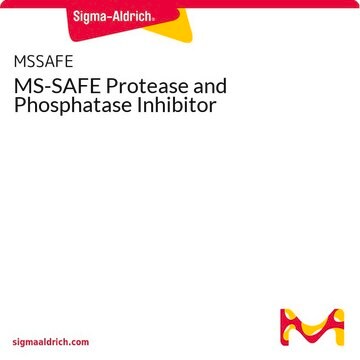PHOSS-RO
Roche
PhosSTOP™
sufficient for 10 10mL buffer preparations, sufficient for 20 10mL buffer preparations, suitable for tissue processing, suitable for immunoprecipitation (IP)
Synonym(s):
inhibitor tablets for phosphatase, phosphatase inhibitor tablets
About This Item
Recommended Products
form
tablet
usage
sufficient for 10 10mL buffer preparations
sufficient for 20 10mL buffer preparations
packaging
pkg of 10 tablets (04906845001)
pkg of 20 tablets (04906837001)
manufacturer/tradename
Roche
technique(s)
immunoprecipitation (IP): suitable
tissue processing: suitable
solubility
aqueous buffer: soluble
storage temp.
2-8°C
General description
Specificity
Application
- lysis buffer for the lysis of frozen mouse tissue to obtain protein supernatant
- lysis of bone derived macrophages
- nuclear extraction buffer for cell lysis and immunoprecipitation
PhosSTOP tablets can be applied in combination with cOmplete Protease Inhibitor Cocktail Tablets to simultaneously protect proteins against dephosphorylation and proteolytic degradation. Both inhibitor tablets maintain their activity when used together.
PhosSTOP inhibitors were evaluated for their effect on protein assays. The inhibition shows almost no influence on BCA or Bradford protein assays.
Features and Benefits
- Comprehensive protection: Inhibit acid and alkaline phosphatases, as well as serine/threonine (PP1, PP2A, and PP2B) and tyrosine protein phosphatases.
- Safe: Dissolve the non-toxic PhosSTOP Tablets in aqueous solutions and avoid organic solvents (e.g., DMSO).
- Suitable for formalin fixation: Maintain phosphorylation status of proteins in histological sections.
- Convenient: Eliminate the time-consuming search for just the right phosphatase inhibitor.
- Easy to use: Simply drop a quick-dissolving tablet into your buffer.
- Stable: Store stock solutions for 1 month at +2 to +8°C, or for at least 6 months at -15 to -25°C.
For all-inclusive protein protection, combine PhosSTOP with cOmplete or cOmplete ULTRA Protease Inhibitor Tablets to inhibit both phosphatases and proteases.
Preparation Note
Working solution: Solvent is recommended in distilled water or aqueous buffers (including buffers containing formalin).
Dissolve one tablet per 10 ml aqueous buffer. Alternatively, prepare a 10x stock solution in 1 ml dist. water or 100 mM phosphate buffer, pH 7.0. Higher concentrations of stock solutions (e.g., 20x) are possible.
Storage conditions (working solution): 2 to 8 °C
Other Notes
Legal Information
Signal Word
Warning
Hazard Statements
Precautionary Statements
Hazard Classifications
Acute Tox. 4 Oral
Storage Class Code
11 - Combustible Solids
WGK
WGK 3
Flash Point(F)
does not flash
Flash Point(C)
does not flash
Certificates of Analysis (COA)
Search for Certificates of Analysis (COA) by entering the products Lot/Batch Number. Lot and Batch Numbers can be found on a product’s label following the words ‘Lot’ or ‘Batch’.
Already Own This Product?
Find documentation for the products that you have recently purchased in the Document Library.
Customers Also Viewed
Articles
Get maximum protection after protein isolation by using protease and phosphatase inhibitor cocktail tablets from Roche.
Related Content
The phosphatase inhibitors included in PhosSTOP Tablets can be deactivated or removed from a lysate using dialysis.
Cell lysis and protein extraction methods overview various techniques, from detergent solubilization to mechanical disruption, supporting research needs.
Cell lysis and protein extraction methods overview various techniques, from detergent solubilization to mechanical disruption, supporting research needs.
Cell lysis and protein extraction methods overview various techniques, from detergent solubilization to mechanical disruption, supporting research needs.
Our team of scientists has experience in all areas of research including Life Science, Material Science, Chemical Synthesis, Chromatography, Analytical and many others.
Contact Technical Service













